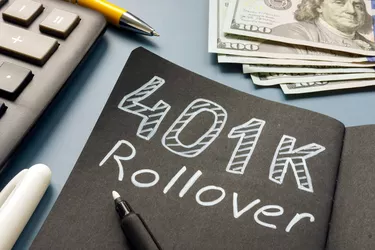
A 401(k) plan is an employer-sponsored retirement plan designed for long-term savings, and as such should not be withdrawn unless you have few other options. The Internal Revenue Service (IRS) levies taxes and penalties to encourage you to keep your money in the account until you retire. If you do not need to withdraw the funds for an immediate need, there are ways to access your account while still avoiding taxation and penalties.
Determine Your Need for Access
Video of the Day
If your need for your 401(k) money is immediate and absolute, you can simply withdraw the assets from the account, and within a few days the money will be wired to your bank account or sent to you in a check. Taking a distribution in this way will subject your entire withdrawal to taxation at ordinary income rates, and if you are under the age of 59 1/2, you will owe a 10 percent early withdrawal penalty as well.
Video of the Day
Consider a Rollover
According to Forbes, if you are leaving your employer for any reason, or if you simply do not like the way the 401(k) plan is administered or invested, you can roll over your assets into an Individual Retirement Account (IRA). An IRA possesses the same tax-deferred growth characteristics of a 401(k), but you are free to invest your IRA in most any publicly traded security, unlike in a 401(k) plan where you normally have only a limited selection of mutual funds from which to choose. Additionally, a rollover to an IRA is both tax- and penalty-free. The downside of such a rollover is that you will no longer receive employer contributions to your account, as you most likely did with your 401(k).
Look at Loan Options
As an added advantage of a 401(k), companies often allow you to take loans from the account, generally up to 50 percent of the account value. Fidelity reports that a loan is not considered a distribution, so you will not have to pay taxes or penalties on the loan, but you will have to maintain a repayment schedule, as with any other loan. With a 401(k) loan, however, you pay the principal and interest back to your own account, rather than to an institution.
Contact Your Plan Administrator
When you have selected your course of action, contact your 401(k) trustee and ask for the appropriate paperwork. Whether you are taking a full withdrawal, requesting a loan or initiating a rollover, you will have to provide information on where you want the money to go, and in the case of a distribution, if you want any taxes withheld.
Be aware that if you take a 401(k) loan and leave your employer for any reason, the entire balance is generally due within 60 to 90 days, or else the entire outstanding loan balance will be considered a taxable distribution.
- Forbes: How to Roll Over Your 401(k) To an IRA
- Fidelity: Thinking of Taking Money Out of a 401(k)?
- IRS: Considering a Loan from Your 401(k) Plan?
- Ameriprise Financial: Borrowing or Withdrawing Money From Your 401(k) Plan Before You Retire
- CNN Money: Ultimate Guide to Retirement: What if I Need the Money Before I Retire?